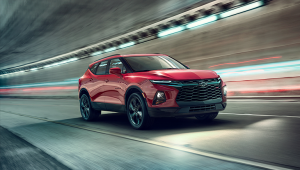
The Bland Blazer of 2020
The automotive news of the week is that the Chevy Blazer is making a comeback, albeit as a contemporary crossover and without the body-on-frame four-wheel-drive cred of its two prior incarnations.
 That’s the extent of the reporting that we have seen thus far surrounding this announcement, overlooking, in our opinion, the fact that the new Blazer will be derivative in every way. It will, to torture a phrase, blaze no new trails.
That’s the extent of the reporting that we have seen thus far surrounding this announcement, overlooking, in our opinion, the fact that the new Blazer will be derivative in every way. It will, to torture a phrase, blaze no new trails.
The original Blazer of 1969 was a full-size SUV based on the Chevy trucks of the time. It later morphed into the Tahoe, and the Blazer name moved to the smaller S-10 platform. Both the large and the small vehicles were of body-on-frame construction and both possessed appreciable off-road capability.
The full-size Tahoe remains available today, tarted up with luxury accouterments as are most SUVs at this point, but still a body-on-frame truck with good off-road proficiency. The smaller Blazer disappeared in 2005, and the last vestige of the name, the TrailBlazer, rode off into the sunset in December of 2008.
But with SUVs and crossovers of all sizes being the hottest automotive segments currently, bulking up the Chevy line with one that will fall between the existing Equinox and Traverse crossovers makes sense. The new Blazer will be a unibody design with front-wheel or all-wheel drive options, and with decent towing capacity, but with no serious pretensions of off-road prowess.
Alas, where Chevy was once a leader in style and design, the new Blazer is anything but. Wholly conventional in mechanical design, engines are either a 2.5-liter four-cylinder with 193 horsepower and 188 lb-ft of torque or a 3.6-liter V6 with 305 horsepower and 269 lb-ft of torque. Neither of these engines are new, and both are antediluvian compared to some of what the competitors offer. Only one transmission will be available, a nine-speed automatic.
Okay, given the market forces of today, the new Blazer can be forgiven for hewing to a proven formula. The days of Chevrolet introducing groundbreaking designs such as the original small block V8 or of GM making bold engineering statements such as the Corvair or Toronado are long gone, and that the new Blazer aims right at the heart of the market is no surprise. But it disappoints us to see GM, once the world’s largest and most innovative automaker, choosing to pursue the lowest common denominator and not seeking to excel.
Worse, though, is the sad fact of the new Blazer’s external styling. Where once GM’s styling studios, rooted in the company’s Art & Colour Section founded in the 1920s, produced a wide range of vehicles with superior eye appeal and resultant showroom success, it appears that now the styling studio has been replaced with a photocopier. The new Blazer looks like a mashup of style elements lifted from the other automakers.
Chief among these elements is the grille, apparently intended to evoke the current Camaro but instead looking more like a Lexus or Toyota than any Camaro. Then there’s the roof treatment at the rear, incorporating a “floating roof” element seen on several other brands including Nissan.
Without any inspiration in design, what will inspire buyers to choose the Blazer?
Well, at least it appears that the Chevy bowtie logo is transitioning to a chrome-trimmed black from the gold that has been in use for too many years. That’s a start. But the new Blazer, while thankfully avoiding the total blandness that has made most recent Chevrolet products completely forgettable, makes a statement that says, “nothing new here.” ![]()

